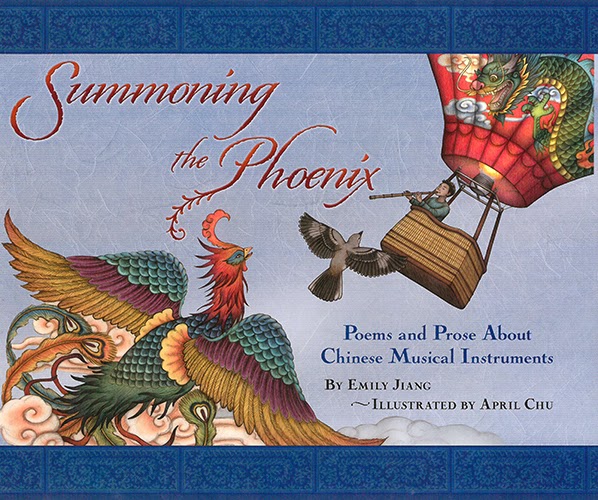Summoning the Phoenix
Summoning the Phoenix: Poems and Prose About Chinese Musical Instruments
By Emily Jiang
 Illustrated by April Chu
Illustrated by April Chu
Twelve children assemble, one by one, with their musical instruments, to perform on stage. Thirteen poems capture the mood via upbeat free verses that let us peek into each of the performer's preparations and rehearsals, set in imagined and real landscape.
The illustrations are breathtaking, with nuances tucked in that speak to the talent of Ms.Chu. The title page shows a concert hall lobby full of expectant audience looking through the program sheets and clustering in small groups, waiting for the doors to open. That sets the stage.
From Ehru to Paigu, the poems show the children talking about their instrument in a loving way, with notes on the side to help us learn about these ancient musical instruments, including the percussion instruments at the end.
Ruan (roo-an) is the younger child's favorite, dubbed Chinese banjo by the kid; whereas Xiao (shao) is easily the older child's favorite thanks to the legend about its magical powers of summoning the phoenix. The illustrations for the Xiao poem is magical.
The poem for Guzheng (goo-zeng), a large stringed instrument, evokes an idyllic natural setting of mountains and waterfalls; and the illustration for it is out of this world.
While the instruments are all traditionally Chinese, the modern-day children playing these instruments are depicted with varying ethnicities and ages, adding to the multicultural richness of the reading experience.
Reading Emily Jiang's Favorite Bit of the book gives that much-coveted backstage pass access to the coming together of two brilliant minds, albeit independently, to create this thing of beauty.
This post written for Saffron Tree's Children's Book Week celebration.
[Disclosure: Although I received this book as a free review copy, the decision to share it and the views expressed here are entirely my own.]
[image source: Lee & Low Books]
By Emily Jiang
 Illustrated by April Chu
Illustrated by April ChuTwelve children assemble, one by one, with their musical instruments, to perform on stage. Thirteen poems capture the mood via upbeat free verses that let us peek into each of the performer's preparations and rehearsals, set in imagined and real landscape.
The illustrations are breathtaking, with nuances tucked in that speak to the talent of Ms.Chu. The title page shows a concert hall lobby full of expectant audience looking through the program sheets and clustering in small groups, waiting for the doors to open. That sets the stage.
From Ehru to Paigu, the poems show the children talking about their instrument in a loving way, with notes on the side to help us learn about these ancient musical instruments, including the percussion instruments at the end.
Ruan (roo-an) is the younger child's favorite, dubbed Chinese banjo by the kid; whereas Xiao (shao) is easily the older child's favorite thanks to the legend about its magical powers of summoning the phoenix. The illustrations for the Xiao poem is magical.
The poem for Guzheng (goo-zeng), a large stringed instrument, evokes an idyllic natural setting of mountains and waterfalls; and the illustration for it is out of this world.
While the instruments are all traditionally Chinese, the modern-day children playing these instruments are depicted with varying ethnicities and ages, adding to the multicultural richness of the reading experience.
Reading Emily Jiang's Favorite Bit of the book gives that much-coveted backstage pass access to the coming together of two brilliant minds, albeit independently, to create this thing of beauty.
This post written for Saffron Tree's Children's Book Week celebration.
[Disclosure: Although I received this book as a free review copy, the decision to share it and the views expressed here are entirely my own.]
[image source: Lee & Low Books]
Labels: ages 4-8, ages 6-9, books, multiculural, music, picture book, review-copy


0 Comments:
Post a Comment
<< Home